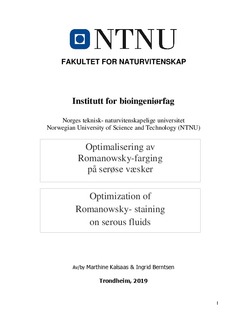| dc.contributor.advisor | Eide, Maj Liv | |
| dc.contributor.advisor | Buan, Camilla Skånøy | |
| dc.contributor.advisor | Grislingås, Andreas | |
| dc.contributor.author | Berntsen, Ingrid | |
| dc.contributor.author | Kalsaas, Marthine | |
| dc.date.accessioned | 2019-08-25T14:06:19Z | |
| dc.date.available | 2019-08-25T14:06:19Z | |
| dc.date.issued | 2019 | |
| dc.identifier.uri | http://hdl.handle.net/11250/2610808 | |
| dc.description.abstract | Bakgrunn: Hensikten med denne oppgaven gitt av seksjon for cytologi, avdeling for patologi, St. Olav Hospital, var å optimalisere forbehandling av pasientprøver med serøse væsker, samt å optimalisere den eksisterende Romanowsky- fargemetoden May- Grünwald- Giemsa for dette prøvematerialet. Det var ønsket å oppnå en kvalitet som tilfredsstiller en score på minst 4 (god) i UK-NEQAS Staining Criteria Handbook –Non Gynae Diagnostic Cytology.
Metode: Det ble foretatt utprøving av ulike Romanowsky fargemetoder både på preparat laget med Megafunnel og på direkteutstryk fra serøse væsker. Ut i fra både innhentet teori og trinn i fargeprotokoller for Romanowsky- farging tilsendt fra andre sykehus, så ble det satt sammen utkast til ulike fargeprotokoller for en rask forprøving. De mest vellykkede og lovende av disse utkastene ble så valgt ut til å bli testet mer nøye videre. Fargeprotokollene ble da kalt henholdsvis ny May- Grünwald- Giemsa (ny MGG), Giemsa i 15 minutter (G15) og Giemsa i 20 minutter (G20), og disse ble programmert inn i fargemaskinen Gemeni AS. I tillegg ble fargekvaliteten til hurtigfargen Color Rapid også vurdert på dennes oppnådde fargekvalitet på lik linje med de nye fargeprotokollene.
Preparater og direkteutstryk ble laget i to store batcher fra åtte ulike pasientprøver. Det ble gjennomført farging hver ukedag i en hel uke, med to preparat fra hver pasientprøve til hver protokoll, dette gjaldt også den protokollen som er til daglig bruk ved seksjonen. Fargeresultat fra den nåværende brukte protokollen ble brukt som sammenligningsgrunnlag for de andre nye fargeprotokollene, men ble også brukt for å undersøke hva som skjer med fargene dersom man ikke har nylagde farger hver dag, men i stedet bare lager nye farger to ganger i uken.
Resultater: Både ny MGG og G15 viste gode resultater i forhold til den nåværende brukte MGG protokollen. G20 gav for mørk kjernefarge. Hurtigfargemetoden gav et utilfredsstillende resultat.
Konklusjon: Både protokoll for ny MGG og G15 oppnådde et bedre fargeresultat enn den nåværende brukte fargeprotokollen ved seksjon for cytologi. Fargeprotokollen for ny MGG anbefales, da denne gav en mer dimensjonal og tonet visualisering av cellebildet, enn det fargeprotokollen G15 klarte. Begge oppnådde en helhetlig score på 4, mens den nåværende brukte fargeprotokollen oppnådde en score på 3. | |
| dc.description.abstract | Background: The purpose of this task given by Section for Cytology at the Department of Pathology at St. Olav Hospital, was to optimize pretreatment of patient samples with serous fluids, as well as to optimize the existing Romanowsky staining method, May- Grünwald- Giemsa for this material. It was wanted to achieve a quality that meets a score of at least 4 (good) in the UK-NEQAS Staining Criteria Handbook –Non Gynae Diagnostic Cytology.
Method: Various Romanowsky- staining methods were tested on both preparations made with Megafunnel and on direct smears from serous liquids. Based on both obtained theory and steps in staining protocols sent to us from other hospitals, drafts to different new staining protocols were put together for a quick preview. The most successful and promising of these drafts were then selected to be more carefully tested, in the staining protocols called new May-Grünwald-Giemsa (new MGG), Giemsa for 15 minutes (G15) and Giemsa for 20 minutes (G20), and was programmed into the Gemeni AS staining machine. In addition, the fast stain Color Rapid was also assessed on its achieved staining quality, similar to the new staining protocols. Preparations and direct smears were made in two large batches from eight different patient samples. Staining was carried out every weekday for a whole week, with two preparations from each patient sample for each protocol, this also applied to the daily used protocol at the section of Cytology. Staining results from the current used protocol were used as a basis not only for comparison for the other new protocols, but were also used to examine what happens to the staining result if one does not use freshly prepared stains every day, but only prepare these two times a week instead.
Results: Both new MGG and G15 showed good results compared to the current used MGG protocol. G20 gave a too dark nuclear stain. The fast staining method gave an unsatisfactory staining result.
Conclusion: Both of the new Romanowsky- staining protocols, MGG and G15, achieved a better staining result than the current used staining protocol at section of Cytology. The new MGG staining protocol is recommended as it provided a more dimensional and toned visualization of the cell image than the G15 staining protocol. Both achieved an overall score of 4, while the current used staining protocol achieved a score of 3. | |
| dc.language | nob | |
| dc.publisher | NTNU | |
| dc.title | Optimalisering av Romanowsky-farging på serøse væsker | |
| dc.type | Bachelor thesis | |
